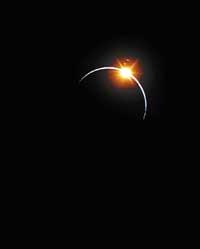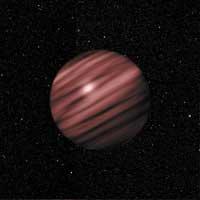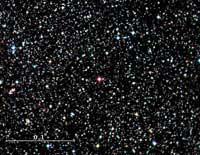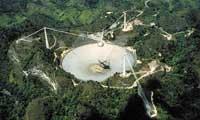The list of new worlds is already large
In fact, telescopes have not yet taken the picture of exoplanets. They have found more than 110 but have not seen it. It is understandable: you can hardly take a picture of the planet Pluto, the last planet of our system, and it will be more difficult to take a picture of a planet outside the Solar System.

Obviously, it is a distance problem. Closer, Pluto may be 4.3 billion kilometers from Earth. And if there were a planet around the star closest to the solar system, around a star of the Alpha Centaur system, it would be 4.2 light years (40 billion kilometers), that is, 9,300 times farther than in Pluto.
In addition, although for various reasons it would be a very interesting discovery, in Alfa Centauro no planet has been found for the moment. The nearest exoplanet found is found in the Epsilon Eridani star system, within 10.4 light years, i.e. 2.5 times farther than Alpha Centauri. The numbers are giant. Therefore, it is easy to understand that a telescope that can see an exoplanet has not yet been made.
However, Pluto is a very small planet, even compared to ours. That is why he has not been taken an exact photo, because besides being very far away, it is very small. It only has a radius of 1.195 kilometers. On the contrary, most of the exoplanets detected are of size equal to or greater than that of Jupiter.
One of the largest has a mass 13.75 times greater than Jupiter (since it is not clear if the planet or star is nano brown), so if both have similar characteristics, the radius of the exoplanet will be approximately 167,000 kilometers. Planet much larger than Pluto. But it is found 102 light-years from Earth, a distance seen 1,700 times lower than in Pluto.
It is clear, it is not seen.
Other exoplanets have been found in much closer stars, but they are also smaller, and if they were large, they should not be seen at first glance.
Balance
Knowing all this, a question arises, how do these exoplanets detect? The answer is simple, but perhaps hard to believe. Astronomers do not have to see optically to find things in space. The study of several radiations allows to discover many details of the stars, even if they have planets around them. The method is based on the interaction between stars and planets.
Stars move very slowly but move. If there is no planet around, they move in a straight line (seen from Earth and with the stars that are farther behind, of course). But if there is a big planet nearby, the star advances in a sinusoidal movement that moves as if it danced.
In this case, the star and the planet revolve around the mass center of the system.
It is the same thing that happens to the Sun with Jupiter. We didn't notice it, but if we could see the solar system from outside, we would see the sunlight dancing. In the Solar System, Jupiter is responsible for this movement, as the other planets are too far away or too small to have a remarkable influence. But the exoplanets found are the size (or larger) of Jupiter and are also very close to the star. To compare, we should imagine a planet larger than Jupiter in the orbit of Venus. The influence of the planet on this system is very high, so dance is very remote.
Analyzing the light
That same effect has been the key to finding exoplanets. Astronomers perceive the dance of stars with planetarium analyzing the light that comes from there. They are very small disturbances, rather, very distant, but sufficient to detect the presence of large planets.

From the light we receive, most exoplanets have been found by astronomers with the radial velocity technique so far. In short, this technique measures whether or not the Doppler effect occurs in the light coming from the star. If the star advances and recedes towards us, the Doppler effect occurs in the light it emits, that is, when the light comes close to us, it whips a little and turns away golden. And that variability can be measured.
If it changes, astronomers recognize that there is influence of a planet; if it does not change, there are no planets as large as to occur.
As mentioned, most exoplanets have encountered the technique of radial velocity, but there are other techniques to measure the variability of light. For example, astrometry is also used to investigate this disturbance. This technique, instead of directing towards us, measures the changes of movement in any other direction. If the movement is linear, that star has no planet around, but if it is "balancing" it moves under another influence. However, when the stars move very slowly, this technique is not usually very precise, taking a lot to measure a small part of the route.
The star light we receive would also change into a hypothetical eclipse. So if between the Earth and the star passed the orbit of a nearby planet, occasionally we would receive less light. In these cases, the intensity of light would vary and also cyclically. Therefore, in theory photometry also helps to look for exoplanets.
However, in most cases, astrometry and photometry have been complementary techniques for astronomers. If we ask about the exoplanet search technique, we should answer that it is a radial velocity technique.
Doubts and planetamania
The technique, the remote search of planets is a very heavy work and based on many hypotheses. According to astronomers, the disruption is caused by planets, but it can be thought that something else has influenced. Believe or not, there is no other clear hypothesis that explains the behavior of many stars. It is very difficult for a body that is not a big planet or a group of bodies to do so much. It is true. It may be something else, but the most logical explanation astronomers have is that of the big planet.

However, it must be recognized that most astronomers working in the field of exoplanets are looking forward to finding new planets. They have been caught by a kind of planamania. And perhaps as a result, they interpret the dubious data the way they want. In fact, many exoplanets have been announced, but not all have been confirmed and some of them have been discarded.
For example, dust rings around stars have created great uncertainty. Dust rings surrounding several stars were detected in the mid-1980s and in some cases were not geometrically perfect, but sometimes dust bubbles have been found or, on the contrary, dust concentrations. In both cases the planets of new creation have been taken as the origin of the effect, but isn't it too much? German astronomer Paul Kalas of the Max Planck Institute, for example, has written in the journal Science on the risk of planetamania.
As in other subjects, it will be best to wait. Time will bring many answers.
Brown dwarfs and giant planets The exoplanets that have already been found are very large. Of course. These are the easiest to detect. But, although with the data we have at our disposal we have assumed that they are large planets, doubt is reasonable. The found stars could be brown dwarfs instead of giant planets. According to theoretical calculations, brown dwarfs do not have enough mass to fuse hydrogen, but enough to allow deuterium, too small to be stars and too large to have planets. They are hot stars, but they do not emit much light: they release most as infrared waves, so they are brown. It is estimated that 'planets' (or larger) with 13 times more mass than Jupiter can be brown dwarfs. The truth is that it is difficult to clarify; since brown dwarfs were discovered, the definition of the planet has been compromised. |
Alfa Centauri: close and in condition
Alpha Centauri is the closest star system to the Sun. It is a system of three stars, three stars near the Sun, at only 4,2-4,3 light-years. It is no wonder that many astronomers look at Alfa Centauro.

No planet has been found there, but it would be good news for astronomers. In fact, one of these three stars, the Alpha Centauri A, is similar to the Sun, both because of its size and the type of light it emits.
Hope has not been lost, but we have to recognize that there is an important difference: the stars A and B of this system spin each other very close. Exoplanets have been found in binary systems, but whenever the distance between two stars is very large: the planet has orbit around a single star and the other star is much farther (700 times farther than the planet, for example).
In Alpha Centaur stars A and B are very close and there does not seem to be a planet between them. At the moment they have not found it. Only for the moment. Will Alfa Center surprise you?
First exoplanet

Exoplanet is the discovery of the 90s. Previously it was only useless attempts and unconfirmed confusing data. In those times no one would have said that the first discovered exoplanet had orbit around a pulsar. This neutron star has a large mass and a fast rotation, supposedly because another star "feeds" it, that is, it expels matter continuously. A planet should not survive in the orbit of a pulsar.
But in 1991 astronomers discovered something surprising with the Arecibo radio telescope. They saw that the radiation of the pulsar PSR1257+12 had cyclic disturbances. They were two exoplanets, revolving around the pulsar.





